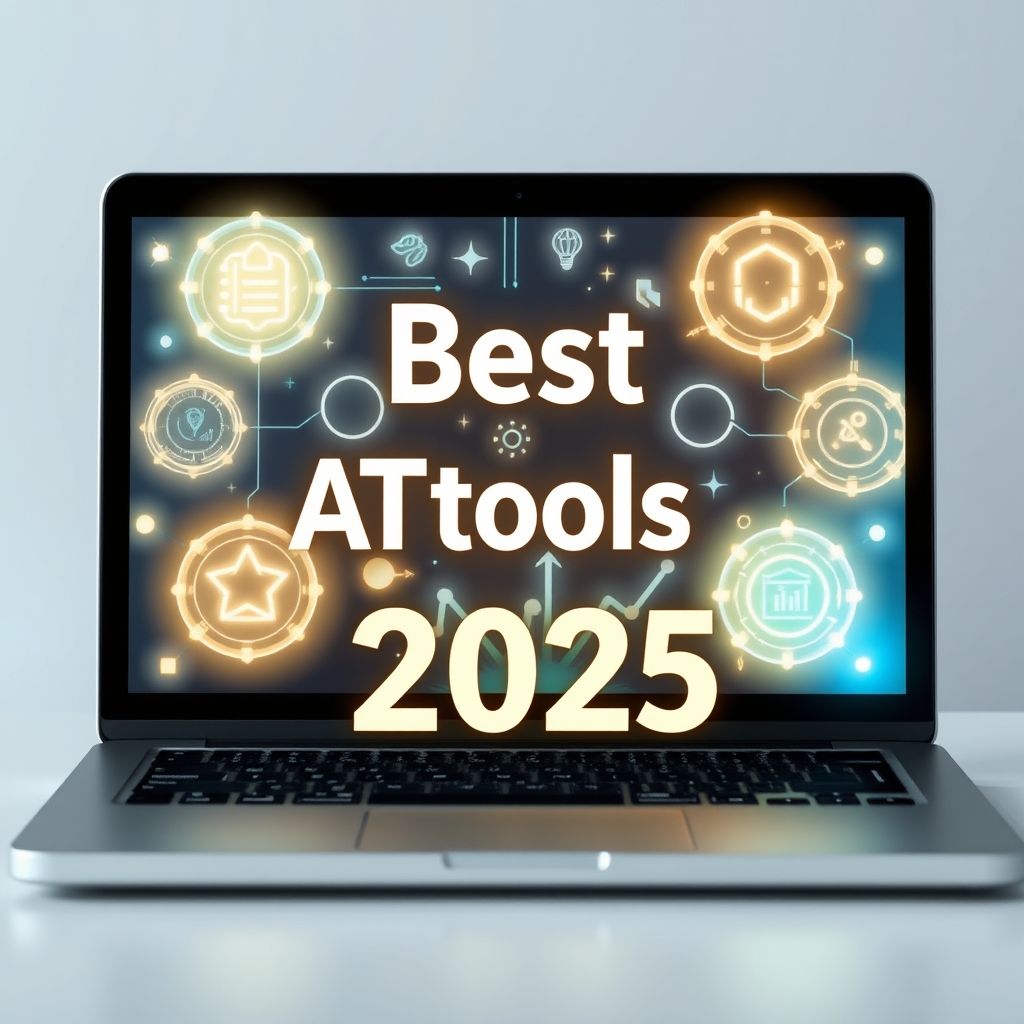
Artificial Intelligence (AI) is no longer just a tech buzzword — in 2025, it’s a daily companion for students, professionals, and even casual users. Whether it’s helping you draft an email, analyze data, create designs, or learn a new language, AI tools are now accessible to everyone — not just tech experts.
If you’ve been curious about AI but don’t know where to start, this guide will walk you through the best AI tools in 2025, explain how to choose the right ones, and give you beginner-friendly tips to get the most value from them.

Why AI Tools Are Everywhere in 2025
Table of Contents
Over the past few years, AI has evolved from a futuristic concept into an everyday necessity. Thanks to advances in machine learning, cloud computing, and natural language processing, today’s AI tools are:
- Faster – They deliver results in seconds.
- Smarter – They understand context, tone, and even creativity.
- More affordable – Many offer free plans or affordable subscriptions.
From chat-based assistants that help you brainstorm to automation tools that handle repetitive work, AI now empowers anyone to work smarter, not harder. And in 2025, competition among AI companies means you have more options than ever.

How to Choose the Right AI Tool for You
1. Define Your Goal
Do you need help with writing, data analysis, design, or learning? Knowing your primary use case will help you choose the right platform.
2. Free vs. Paid Options
Many AI tools offer free trials or limited free plans. Start free, then upgrade only if you truly need advanced features.
3. Ease of Use
If you’re a beginner, look for tools with simple dashboards, guided tutorials, and good customer support.
4. Privacy and Security
Read privacy policies. If you’re handling sensitive information, choose AI tools that offer data encryption and transparent security practices.

Best AI Tools for Everyday Productivity
Chat-Based Assistants
- ChatGPT (OpenAI) – Great for brainstorming ideas, drafting text, summarizing articles, or even creating study plans.
- Claude (Anthropic) – Known for its conversational depth and ability to process longer text documents.
Task Automation
- Zapier AI – Automates repetitive tasks like sending emails, posting to social media, or updating spreadsheets.
- Notion AI – Turns your notes and tasks into smart workflows, summaries, and checklists.
Email and Writing Help
- GrammarlyGO – AI-powered writing assistance with tone adjustments and quick content generation.
- Jasper – Popular for marketing copy, blog drafts, and ad campaigns.
Best AI Tools for Students
Research and Summarization
- Perplexity AI – Provides accurate, cited answers to research questions in seconds.
- ScholarAI – Integrates with academic databases for reliable study references.
Study Assistance
- Quizlet AI – Creates flashcards and quizzes from your study materials.
- Notion AI – Generates summaries, organizes class notes, and helps with project planning.
Language Learning
- Duolingo Max – Uses AI to offer personalized lessons, real-time speaking feedback, and conversation practice.

Best AI Tools for Small Businesses
Marketing Content Creation
- Copy.ai – Generates ad copy, blog intros, and product descriptions.
- Writesonic – Versatile AI writing platform with SEO optimization features.
Customer Service Automation
- Tidio AI – Chatbot that handles customer queries 24/7.
- Intercom AI – Combines customer support with proactive engagement.
Data and Analytics
- Tableau AI – Simplifies complex data into clear visual reports.
- MonkeyLearn – Categorizes and analyzes customer feedback for insights.
Free AI Tools Worth Trying First
If you’re just starting with AI, here are some excellent free AI tools:
- ChatGPT Free – For brainstorming, text generation, and Q&A.
- Canva AI – For quick design creation.
- Perplexity AI – For fact-based research.
- Notion AI Free Plan – For personal productivity.
- Grammarly Free – For basic grammar and tone correction.
Tip: Start with one or two tools, then expand as you get comfortable.

Tips for Getting the Most Out of AI Tools
1. Learn Prompt Crafting
AI’s output depends heavily on your input. Instead of saying “Write me an article,” try “Write me a 500-word article about the benefits of remote work, with a friendly tone and bullet points.”
2. Combine Multiple Tools
Use AI in combination — for example, write an outline in ChatGPT, design visuals in Canva AI, and schedule posts with Buffer AI.
3. Stay Updated
AI evolves rapidly. Subscribe to newsletters or follow AI blogs to discover new tools and features as they launch.
The Future of AI Tools
Looking ahead to 2026, AI tools will become even more personalized and integrated into our devices. Expect:
- AI that adapts to your style of writing or speaking.
- Seamless voice-controlled AI assistants.
- More affordable subscription models as competition grows.
For beginners, starting now means you’ll be ahead of the curve when more advanced features roll out.
Final Thoughts, well, almost!
AI is no longer a distant, sci-fi concept — it’s a practical, everyday assistant. Whether you’re a student juggling assignments, a professional trying to boost productivity, or a small business owner looking to save time, there’s an AI tool for you. Look around you, you’ll be surprised to note that so many people have already embraced some AI tool or the other!
Start small, explore free options, and remember: the real power of AI isn’t just in automation — it’s in helping you focus on the things that matter most.
💡 Quick Recap of Must-Try AI Tools in 2025:
- ChatGPT – Conversations, brainstorming, summaries.
- Perplexity AI – Fact-checked research.
- Notion AI – Productivity and note organization.
- Copy.ai – Marketing content.
- Canva AI – Quick and easy design.

The Future of AI Tools: What to Expect Beyond 2025
The future of AI tools promises even more advanced, personalized, and accessible solutions that will reshape the way we work, learn, and create. As artificial intelligence continues to evolve, expect AI platforms to integrate seamlessly into our daily lives — from voice-activated assistants managing household tasks to AI-powered analytics guiding business strategies in real-time.
One major trend is hyper-personalization. AI tools will adapt to individual user preferences, learning your writing style, problem-solving approach, and even your tone of voice. This will make AI-generated content feel more authentic and tailored.
Another significant development will be multi-modal AI — tools capable of understanding and processing text, images, audio, and video simultaneously. This means you could brainstorm an idea verbally, have it visualized instantly, and generate a polished written version in seconds.
We’ll also see more industry-specific AI tools. Healthcare, education, marketing, and small business sectors will benefit from AI designed to address unique challenges, from medical diagnostics to personalized learning plans.
Affordability and accessibility will improve as competition among AI providers grows. More free AI tools will emerge, while premium options will offer cutting-edge features at lower costs. However, ethics and privacy will remain top priorities, with increased transparency and better data protection measures.
In short, the future of AI tools is about smarter, faster, and safer technology that empowers people to focus on creativity, decision-making, and innovation — while letting AI handle the repetitive and time-consuming tasks.
*I hope you have enjoyed reading this article as much as I have enjoyed writing it! Please watch this space for more articles and reviews, and navigate through the links below for additional information. Thank you! *

Be First to Comment